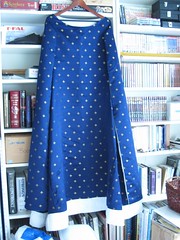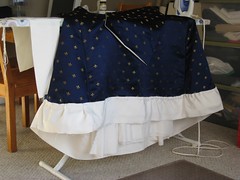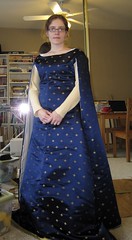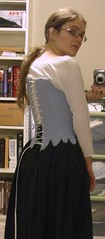Very few historical outfits are complete without the appropriate headgear. Even when hats or veils aren't particularly called for, the right hairstyle can really put the finishing touch on an ensemble. And since I'm primarily working in the 15th century, I have a delightful variety of outlandish hats to choose from.
The hat I am working on at the moment will accompany the fleur-de-lys gown in the style from the Très Riches Heures. At its core, its really just a padded roll, albeit a very large one and extensively decorated. Because of this, it doesn't call for the wires or stiffening usually associated with hatmaking - just fabric, stuffing, and ordinary sewing tools.
Very narrow padded rolls can be made with just a straight tube of fabric, particularly if it is cut on the bias. As it is bent around the head, the inner portion of the ring automatically forms small folds. However, as they become larger, it becomes necessary to shape the fabric for the roll, as the folding and bunching would become excessive. In making my roll, I still started with a straight rectangle of fabric. I decided that the lengthwise seam would go along the outer edge, and then I put tucks in at even intervals such that the center line of the piece (which becomes the head opening, the smallest point) was much shorter than the two edges. If you're having trouble picturing that, here's how it works in practice: fold the fabric cross-wise at the point you want to put in the tuck. Stitch from edge to edge in a sideways V shape: very close to the fold at each end, and farther away at the center line. Carefully stitch the long edge, leaving an opening so that you don't form a donut which can't be turned rightside out. Stuff, pin or baste the opening closed, and try on. It may require several tests to get it right - expect the tucks to become more severe to shrink the head opening. It's also easy to add additional pieces to the end if the overall size is not big enough; just shape the seam like the other tucks. Starting with a long arc (2, really, for top and bottom) rather than a straight piece would probably reduce the need for tucks, but would also require being close to the correct size and shape from the first cut, as it would be more difficult to adjust.
I like a soft wool for the outer material; it has some give and provides a smooth silhouette. Many people go for cotton, but it can produce sharp creases and puckers which I think detract from the overall look. As for stuffing, while unspun wool seems the most likely candidate for an authentic material, polyester fiberfill is cheap, light, and readily available if you're working on a deadline. It is worth spending a little bit more to get the extra soft stuff, though. Keep in mind that it does have a tendency to poke through most materials if they are not very tightly woven - your particular design will dictate whether this will be a problem or not. Mine will be entirely hidden under the embellishment, so I'm not worried.
02 December 2008
16 November 2008
The finish line
Over the past week or so, I've slowly finished the hemming on this gown - both for the contrast band and the inner lining - and secured the lining to the main fabric around the bottom edge. Which means that it is finally, completely finished! I'm planning to wear this to 12th Night, so I probably won't get any 'all dressed up' pictures until then. Accessories have yet to be finished, although I've started on the hat. I do already have a middle layer gown to wear with this, although in the long term I'm planning to replace it with a nicer one, for which I already have the fabric. It's doubtful that I'll get that done soon, though.
Labels:
15th c.,
Très Riches Heures gown
26 October 2008
A tale of two hems
Sometimes you've just got to put your butt in the chair and work on things, even if you're not inspired.
I realized I had a whole day for projects, with nothing planned, and I figured I'd just start working on this dress again so that I can get it off my 'in-progress' list. I still hadn't decided on a floor-skimming vs. a puddling-on-the-floor length, but after trimming the main fabric so it was even, it became obvious that I didn't have enough length to puddle convincingly anyway. So I trimmed off another 4 cm or so, and zig-zagged a 1 cm hem to keep the fabric in check while I worked on the rest.
The turned-up contrast of the lining fabric I've decided to do as an applied band rather than actually turning up the lining (which you can see hanging down in the center of the photo). There are four thicknesses total - 2 lengths of fabric, folded over and pressed at the top of the band. The bottom two layers are sewn to the very edge of the dress to secure them, and the upper layers have extra length which will be folded under and tacked on the inside.
Of course, since the band is straight and the skirt is flared, it is inevitably a bit too wide at the top. My current debate is whether to ease the extra through the entire width (on the right on the photo), or to keep it as smooth as possible and take a few darts in the section over the gores as necessary (on the left). I'm strongly leaning toward the latter, but I'm going to stare at it for a day or two before I commit to one or the other.
I realized I had a whole day for projects, with nothing planned, and I figured I'd just start working on this dress again so that I can get it off my 'in-progress' list. I still hadn't decided on a floor-skimming vs. a puddling-on-the-floor length, but after trimming the main fabric so it was even, it became obvious that I didn't have enough length to puddle convincingly anyway. So I trimmed off another 4 cm or so, and zig-zagged a 1 cm hem to keep the fabric in check while I worked on the rest.
The turned-up contrast of the lining fabric I've decided to do as an applied band rather than actually turning up the lining (which you can see hanging down in the center of the photo). There are four thicknesses total - 2 lengths of fabric, folded over and pressed at the top of the band. The bottom two layers are sewn to the very edge of the dress to secure them, and the upper layers have extra length which will be folded under and tacked on the inside.
Of course, since the band is straight and the skirt is flared, it is inevitably a bit too wide at the top. My current debate is whether to ease the extra through the entire width (on the right on the photo), or to keep it as smooth as possible and take a few darts in the section over the gores as necessary (on the left). I'm strongly leaning toward the latter, but I'm going to stare at it for a day or two before I commit to one or the other.
24 August 2008
Continuing progress on Très Riches Heures gown
Neither I nor this dress are dead yet. I've just set in the sleeves and started attaching the lining.
24 June 2008
Gown assembly
A bit of progress on the Très Riches Heures gown: I've done the preliminary fitting, so it's not quite so oversized. I cut back the lining to match the adjustments to the fashion fabric, and started assembling that. I went back and cut the gores for the lining as well, since I had neglected to do that originally. It may still need to be taken in further, but its starting to shape up. Once I finish assembling the lining, I should be able to set in the neckline and armholes.
As it currently stands, the gown is cut a bit beyond floor length, the idea being that it would puddle on the ground, but the fabric just has too much body to 'puddle' properly. I'm debating trimming the hem down to just barely floor length in the hopes that it might drape better (and be more likely to be worn, honestly), but it might actually make things worse instead. Looks like I'll be perching on stacks of books in the near future to get an idea of how it would behave.
This is probably a bad sign, but I've starting thinking about contingency plans for what I could re-cut the fabric into if this gown doesn't work. A late 16th century forepart skirt is near the top of that list.
As it currently stands, the gown is cut a bit beyond floor length, the idea being that it would puddle on the ground, but the fabric just has too much body to 'puddle' properly. I'm debating trimming the hem down to just barely floor length in the hopes that it might drape better (and be more likely to be worn, honestly), but it might actually make things worse instead. Looks like I'll be perching on stacks of books in the near future to get an idea of how it would behave.
This is probably a bad sign, but I've starting thinking about contingency plans for what I could re-cut the fabric into if this gown doesn't work. A late 16th century forepart skirt is near the top of that list.
10 May 2008
Pushing forward: sleeves done
I've now finished both sleeves, shown in extreme close-up here. Next up is going to be fitting the main gown - I left a lot of ease when I did the cutting, so it's approximately the right shape but rather oversized. Combined with the strong hand of the fabric, it looks like its wearing me rather than vice versa. Pulling it in to be more body skimming should (hopefully) bring that under control.
09 May 2008
WIP, or just a UFO?
I'm very slowly making progress on my Très Riches Heures gown (no pictures right now), but it's beginning to feel like less of a work in progress and more like a (perpetually) unfinished object. The distinction being the optimism, or lack thereof, about whether it will ever be finished. The lining is very thin, which by itself isn't a problem, but when I turned and pressed the first sleeve, the seam allowances and the fray-prevention zigzag on them showed through in a very unattractive way. I unpicked the zigzag all the way around, painstakingly trying not to create any snags or pulls in the satin. Then I re-bound the edges, using an extra fold and much lighter thread, and re-pressed it all once again. It looks much better now, and I know how to handle the second sleeve now, but it was frustrating to spend an entire long evening on the project just to get back to where I started in terms of assembly progress.
I'm also worried that the fabric ultimately won't drape right at all. Heavy satins drape very differently on the grain and the cross-grain (e.g., do the floats run vertical or horizontal on the garment), and I'm afraid I'm going to end up with something that stands out stiffly rather than falling in nice folds. From the moment I saw it, this fabric insisted it wanted to be this gown, but I'm beginning to think that it lied.
I'm also worried that the fabric ultimately won't drape right at all. Heavy satins drape very differently on the grain and the cross-grain (e.g., do the floats run vertical or horizontal on the garment), and I'm afraid I'm going to end up with something that stands out stiffly rather than falling in nice folds. From the moment I saw it, this fabric insisted it wanted to be this gown, but I'm beginning to think that it lied.
Labels:
15th c.,
Très Riches Heures gown
03 March 2008
Finished apron dress
This dress has been done for months, but I hadn't gotten any pictures of it until now. Like I outlined in my post on creating the pattern, it's a very simple cut with 4 identical panels, and each panel has a vertical dart for tailoring. The darts in the back are much shallower than the ones in the front, and might be skipped entirely for some women. The straps are long loops made from 1 inch strips of the same fabric as the dress, folded in itself twice.
I'm happy with the overall fit and look of the dress, but not entirely satisfied with it as a recreation based on the Hedeby fragment. While I was able to incorporate most of the features of the piece, the location of the hole near the upper edge of the piece didn't match up with anywhere I could plausibly position a strap, either on the front or the back.
I'm happy with the overall fit and look of the dress, but not entirely satisfied with it as a recreation based on the Hedeby fragment. While I was able to incorporate most of the features of the piece, the location of the hole near the upper edge of the piece didn't match up with anywhere I could plausibly position a strap, either on the front or the back.
30 January 2008
Talking the talk, and cutting the fabric
Way back in April of last year, I mentioned plans for a court gown based on one in Très Riches Heures. Nine months later, I have finally convinced myself to cut into the very expensive fabric I'm using for the project. I'm using a very simple cut for the gown, to make best use of my limited yardage (6 yards, but only 30 inches wide, with a directional pattern to boot). The front and back are each cut in a single piece, the full width of the fabric - no center front or center back seams. All the shaping will be in the side seams. Triangular gores for the side seams finish out the width of the skirt. I've got enough room to adjust still that I could add center front and back seams, if I find that I need shaping there, but my muslin seemed okay without them and I'm hoping to avoid that if possible. The gown will be a pull-over-the-head style, more body-skimming than tight. Working with heavy satin is hard enough without having to mess with eyelets or buttons or even zippers. The 'sleeves' are completely open, just draped from the armscye. At the top, I've got essentially half of the typical sleevehead shape, just a simple arc, and they gradually widen out to 15 inches by about halfway down, and are straight from there to the bottom. I've decided on a white silk broadcloth for the lining, which will be cut the same way except longer in the body, so I can turn it up on the outside for the contrast hem. The illumination seems to show a patterned edge to the hemline; I'm still thinking about whether to attempt that or to go for a much simpler straight edge.
15 January 2008
18th c. strapless stays: nearly finished
With all the eyelets now done, I can finally actually try these stays on. The fit isn't nearly as bad as I had feared (going to show that holding something up and trying to pull the edges together with your hands isn't a good approximation of lacing it up properly). Still, there's no denying that they are a noticeably small overall. In the front, my chest is pushing out over the top just a bit, which really isn't the look I'd be going for. Some of that is weight gain since I started the project, which will hopefully be fixed with exercise, and some of that is that the finished stays are legitimately smaller than my mock-up, which can hopefully be fixed as they stretch out a bit with wearing.
So this project is going to be on hold for some time, while I see if the stays stretch out enough, or if I need to make major adjustments to improve the fit (like replacing a couple of the sections with new, larger ones). All that really needs to be done to finish them is to put in the lining and bind the top and bottom edges. In the mean time, I've got plenty of other sewing to do.
So this project is going to be on hold for some time, while I see if the stays stretch out enough, or if I need to make major adjustments to improve the fit (like replacing a couple of the sections with new, larger ones). All that really needs to be done to finish them is to put in the lining and bind the top and bottom edges. In the mean time, I've got plenty of other sewing to do.
10 January 2008
New beginnings... slowly
It's been remarkably quiet here, and there's exactly one reason for that: my sewing projects haven't been getting much love lately. There have been plenty of distractions, and winter weather doesn't help (my crafts and projects room is far and away the coldest area of our home in the winter), and the result is that things just haven't gotten done. I've got that spark back in my eye, though, so things may change. One big improvement is that I'm about 2/3 done with a big clean-up of the room - I can see the floor again! Over the next month or so, I'll still be busy trying to push some work-related stuff out the door, but hopefully I'll be able to carve out some time for all the sewing I've got planned. I have finally gotten all the eyelets into the 18th c. stays, meaning I could actually try them on, and the result is neither as good as I had hoped nor as bad as I had feared. I should have a more specific post with pictures up in the next week.
Subscribe to:
Posts (Atom)





